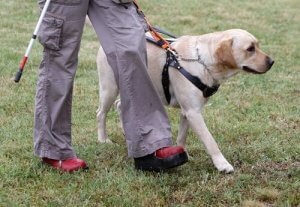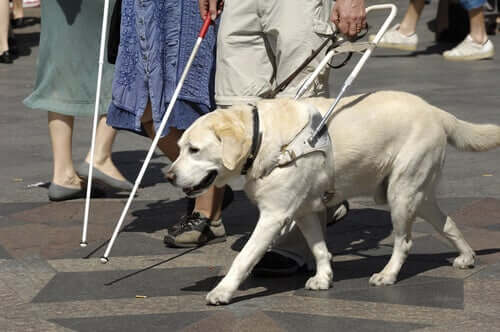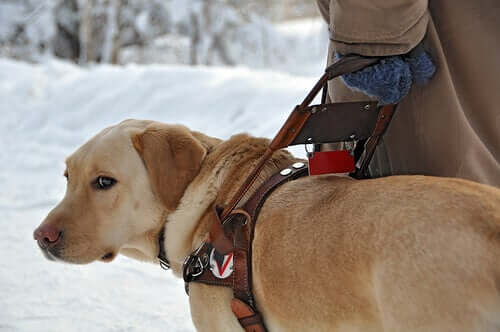The Unique Training of Guide Dogs

Over the course of history, we’ve discovered that dogs have the capacity to carry out a great variety of activities… many of which help improve our lives. One of the most remarkable and valuable jobs that our four-footed friends fulfill is that of a guide dog. They are the eyes of those that can’t see, remaining calm no matter what happens around them. But have you ever wondered what the training of guide dogs entails? Today you’ll find out.
Guide dogs–or seeing-eye dogs–make the lives of those who are blind or visually impaired much easier. And there are a great number of organizations and institutions around the world that are dedicated to training these noble animals. You’re sure to enjoy discovering the work and dedication that goes into the training of guide dogs.
Training guide dogs: the process
As we all know very well, not all dog breeds are able to carry out this task. Therefore, professionals select the types of dogs that possess very specific characteristics. As a general rule, Labradors and Golden Retrievers are most often chosen for the job. However, there are other breeds that are just as capable as long as they fulfill the following personality requirements:

- A desire to please their owners
- A great sense of responsibility
- Perseverance, not giving up easily
- Initiative and resolution
- Adaptability. This involves adapting to their environment and the changes that may occur there
- A protective instinct
Once trainers have verified that dogs possess these characteristics, then it’s time to decide what type of training they’ll receive. This training is very exhaustive and, as we’ll see, it’s very useful because all of these animals carry out wonderful tasks in their work.
The harness
The harness will be the tool that allows humans to tell dogs what they want from them. Likewise, it’s the way dogs have of knowing what their owners want and how they should proceed. So, with that in mind, both owners and dogs must learn to use the harness. In general, dogs stay on the left with most of their bodies ahead of their owners. In other words, it’s dogs that lead the way when walking.
To enable each other to understand one another, they learn to exchange a non-forceful tension via the harness.
The straight line
Even when people can’t see, they’re still responsible for their own orientation. And while a great deal of responsibility falls on seeing-eye dogs, the majority belongs to the dog owner. In other words, dog owners shouldn’t place “blind” trust in their dog’s abilities.
Walking without a guide dog is very different to walking with one. Of course, if a blind person walks without a guide dog, he or she must feel their way around. However, the training of guide dogs involves teaching them to move from one place to another in a straight line. In doing so, they eliminate a great number of obstacles.
So, guide dogs will always walk in a straight line unless they’re instructed to do otherwise, or unless their surroundings require them to modify their path. For example, a curb, a street lamp, or another person.
Curbs
Curbs can pose somewhat of a challenge for blind individuals, so trainers must take special care in teaching guide dogs to deal with them. The dogs must learn to mark the presence of a curb by means of a specific gesture. That is, the animals must stop and sit down so that its owner knows that it’s time to step down.
As for stairs, the animal should stop at the top of the staircase when it’s descending. As for an ascending staircase, guide dogs will place their front paws on the first stair.

Obstacles and traffic
A big part of training guide dogs with a harness is making them understand they are an extension of their owner’s body. Therefore, when it comes to moving around an obstacle, the animal must make sure that both of them fit around it.
In the case of traffic close by, the dog will ignore any orders to advance. When the traffic is further away, the dogs will stay on foot or sit down to wait until the traffic has passed. Just the same, the person should use his or her hearing to know when it’s the best time to cross. It’s always important to remember that an animal’s ability is limited.
Distractions
Seeing-eye dogs are the eyes of the blind and must be attentive to their owners at all times. Any oversight can be fatal. Therefore, these animals learn to ignore distractions. No matter what’s going on around them, guide dogs need to stay focused on their task. For this reason, if you ever see a guide dog at work, you should refrain from calling it or petting it. The only exception to this is if you’re in a relaxed setting and the owner has given you specific permission.
Guide dogs are the most loyal and dedicated animals you can find. They’re willing to undergo intensive training and spend their lives protecting their owners. What more can we say besides “thank you!”?
Over the course of history, we’ve discovered that dogs have the capacity to carry out a great variety of activities… many of which help improve our lives. One of the most remarkable and valuable jobs that our four-footed friends fulfill is that of a guide dog. They are the eyes of those that can’t see, remaining calm no matter what happens around them. But have you ever wondered what the training of guide dogs entails? Today you’ll find out.
Guide dogs–or seeing-eye dogs–make the lives of those who are blind or visually impaired much easier. And there are a great number of organizations and institutions around the world that are dedicated to training these noble animals. You’re sure to enjoy discovering the work and dedication that goes into the training of guide dogs.
Training guide dogs: the process
As we all know very well, not all dog breeds are able to carry out this task. Therefore, professionals select the types of dogs that possess very specific characteristics. As a general rule, Labradors and Golden Retrievers are most often chosen for the job. However, there are other breeds that are just as capable as long as they fulfill the following personality requirements:

- A desire to please their owners
- A great sense of responsibility
- Perseverance, not giving up easily
- Initiative and resolution
- Adaptability. This involves adapting to their environment and the changes that may occur there
- A protective instinct
Once trainers have verified that dogs possess these characteristics, then it’s time to decide what type of training they’ll receive. This training is very exhaustive and, as we’ll see, it’s very useful because all of these animals carry out wonderful tasks in their work.
The harness
The harness will be the tool that allows humans to tell dogs what they want from them. Likewise, it’s the way dogs have of knowing what their owners want and how they should proceed. So, with that in mind, both owners and dogs must learn to use the harness. In general, dogs stay on the left with most of their bodies ahead of their owners. In other words, it’s dogs that lead the way when walking.
To enable each other to understand one another, they learn to exchange a non-forceful tension via the harness.
The straight line
Even when people can’t see, they’re still responsible for their own orientation. And while a great deal of responsibility falls on seeing-eye dogs, the majority belongs to the dog owner. In other words, dog owners shouldn’t place “blind” trust in their dog’s abilities.
Walking without a guide dog is very different to walking with one. Of course, if a blind person walks without a guide dog, he or she must feel their way around. However, the training of guide dogs involves teaching them to move from one place to another in a straight line. In doing so, they eliminate a great number of obstacles.
So, guide dogs will always walk in a straight line unless they’re instructed to do otherwise, or unless their surroundings require them to modify their path. For example, a curb, a street lamp, or another person.
Curbs
Curbs can pose somewhat of a challenge for blind individuals, so trainers must take special care in teaching guide dogs to deal with them. The dogs must learn to mark the presence of a curb by means of a specific gesture. That is, the animals must stop and sit down so that its owner knows that it’s time to step down.
As for stairs, the animal should stop at the top of the staircase when it’s descending. As for an ascending staircase, guide dogs will place their front paws on the first stair.

Obstacles and traffic
A big part of training guide dogs with a harness is making them understand they are an extension of their owner’s body. Therefore, when it comes to moving around an obstacle, the animal must make sure that both of them fit around it.
In the case of traffic close by, the dog will ignore any orders to advance. When the traffic is further away, the dogs will stay on foot or sit down to wait until the traffic has passed. Just the same, the person should use his or her hearing to know when it’s the best time to cross. It’s always important to remember that an animal’s ability is limited.
Distractions
Seeing-eye dogs are the eyes of the blind and must be attentive to their owners at all times. Any oversight can be fatal. Therefore, these animals learn to ignore distractions. No matter what’s going on around them, guide dogs need to stay focused on their task. For this reason, if you ever see a guide dog at work, you should refrain from calling it or petting it. The only exception to this is if you’re in a relaxed setting and the owner has given you specific permission.
Guide dogs are the most loyal and dedicated animals you can find. They’re willing to undergo intensive training and spend their lives protecting their owners. What more can we say besides “thank you!”?
This text is provided for informational purposes only and does not replace consultation with a professional. If in doubt, consult your specialist.








